University Name: PUBH6002 Car Accident Risk Assessment Report
VerifiedAdded on 2022/12/21
|7
|1047
|28
Report
AI Summary
This report provides a detailed analysis of a car accident, examining the phases of the event, including pre-event risk factors, the event itself, and post-event consequences. The analysis considers the host (injured person), agent (object causing injury), and the environment (physical, social, and economic factors). It identifies various risk factors such as alcohol influence, lack of control, environmental hazards, and the impact on public health. The report also analyzes a second scenario involving environmental and social risks faced by a family, including pollution, noise, and financial instability, and suggests potential solutions for these issues. References from relevant literature are included to support the analysis and findings, providing a comprehensive overview of the public health implications of both scenarios.
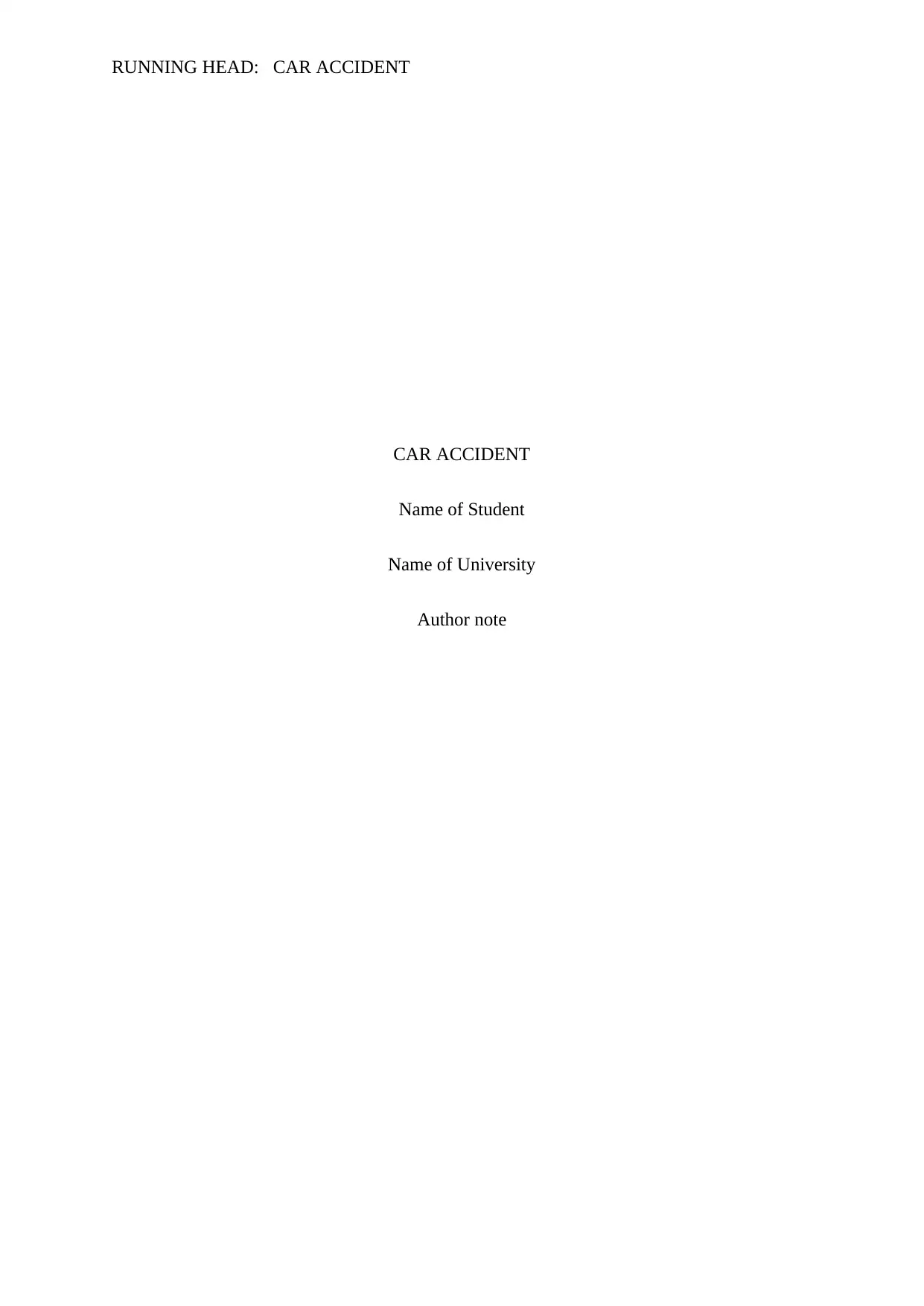
RUNNING HEAD: CAR ACCIDENT
CAR ACCIDENT
Name of Student
Name of University
Author note
CAR ACCIDENT
Name of Student
Name of University
Author note
Paraphrase This Document
Need a fresh take? Get an instant paraphrase of this document with our AI Paraphraser
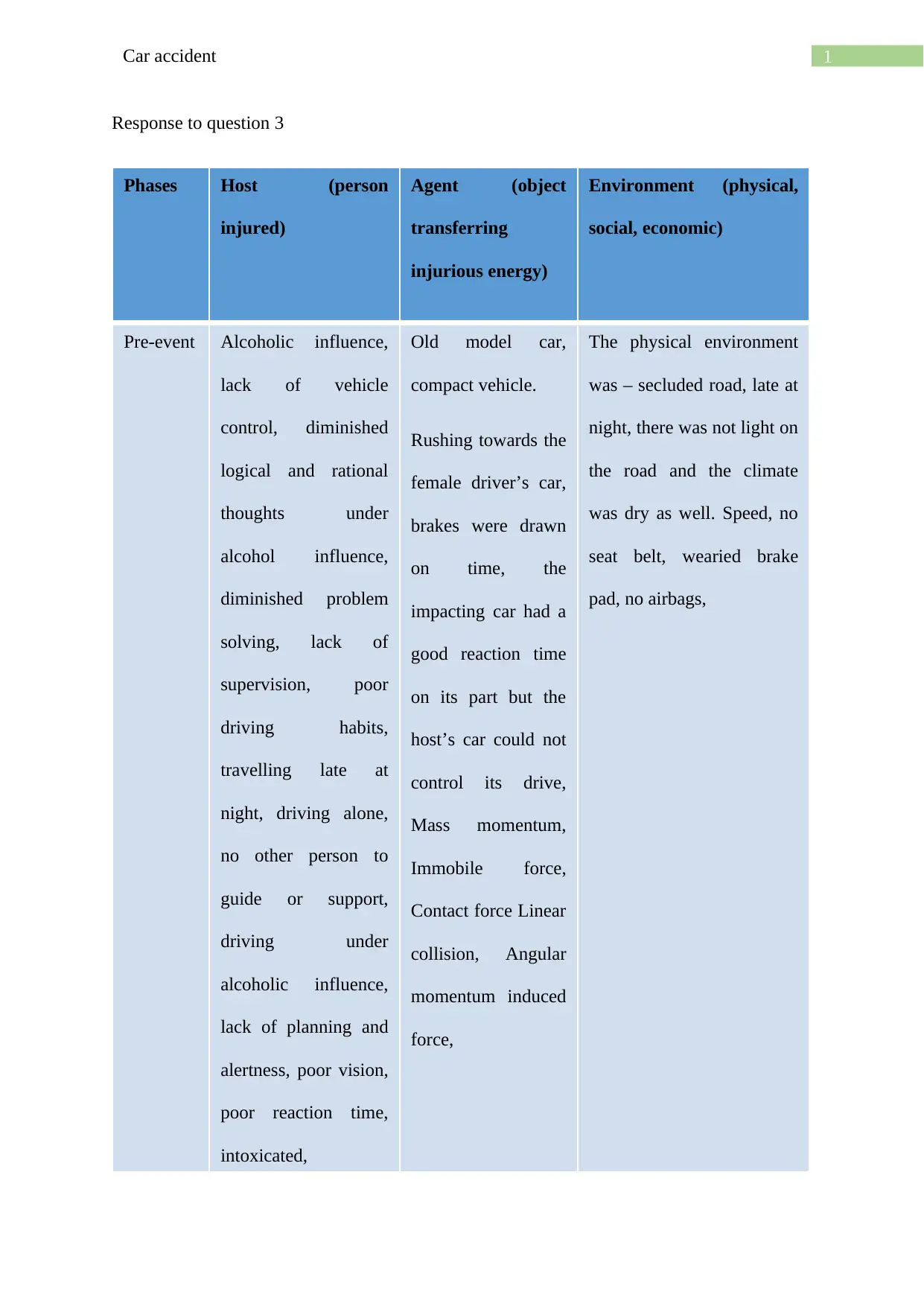
1Car accident
Response to question 3
Phases Host (person
injured)
Agent (object
transferring
injurious energy)
Environment (physical,
social, economic)
Pre-event Alcoholic influence,
lack of vehicle
control, diminished
logical and rational
thoughts under
alcohol influence,
diminished problem
solving, lack of
supervision, poor
driving habits,
travelling late at
night, driving alone,
no other person to
guide or support,
driving under
alcoholic influence,
lack of planning and
alertness, poor vision,
poor reaction time,
intoxicated,
Old model car,
compact vehicle.
Rushing towards the
female driver’s car,
brakes were drawn
on time, the
impacting car had a
good reaction time
on its part but the
host’s car could not
control its drive,
Mass momentum,
Immobile force,
Contact force Linear
collision, Angular
momentum induced
force,
The physical environment
was – secluded road, late at
night, there was not light on
the road and the climate
was dry as well. Speed, no
seat belt, wearied brake
pad, no airbags,
Response to question 3
Phases Host (person
injured)
Agent (object
transferring
injurious energy)
Environment (physical,
social, economic)
Pre-event Alcoholic influence,
lack of vehicle
control, diminished
logical and rational
thoughts under
alcohol influence,
diminished problem
solving, lack of
supervision, poor
driving habits,
travelling late at
night, driving alone,
no other person to
guide or support,
driving under
alcoholic influence,
lack of planning and
alertness, poor vision,
poor reaction time,
intoxicated,
Old model car,
compact vehicle.
Rushing towards the
female driver’s car,
brakes were drawn
on time, the
impacting car had a
good reaction time
on its part but the
host’s car could not
control its drive,
Mass momentum,
Immobile force,
Contact force Linear
collision, Angular
momentum induced
force,
The physical environment
was – secluded road, late at
night, there was not light on
the road and the climate
was dry as well. Speed, no
seat belt, wearied brake
pad, no airbags,
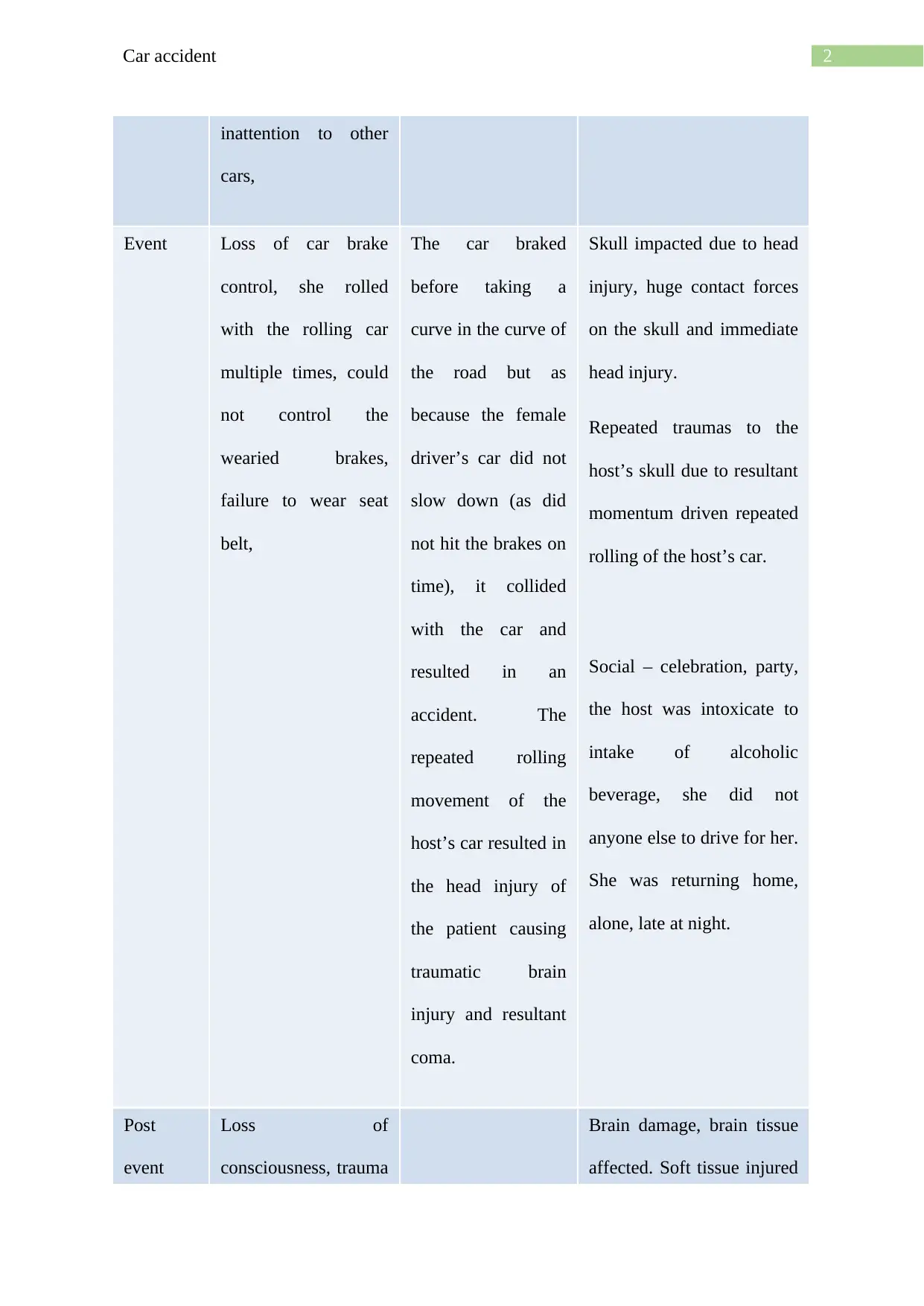
2Car accident
inattention to other
cars,
Event Loss of car brake
control, she rolled
with the rolling car
multiple times, could
not control the
wearied brakes,
failure to wear seat
belt,
The car braked
before taking a
curve in the curve of
the road but as
because the female
driver’s car did not
slow down (as did
not hit the brakes on
time), it collided
with the car and
resulted in an
accident. The
repeated rolling
movement of the
host’s car resulted in
the head injury of
the patient causing
traumatic brain
injury and resultant
coma.
Skull impacted due to head
injury, huge contact forces
on the skull and immediate
head injury.
Repeated traumas to the
host’s skull due to resultant
momentum driven repeated
rolling of the host’s car.
Social – celebration, party,
the host was intoxicate to
intake of alcoholic
beverage, she did not
anyone else to drive for her.
She was returning home,
alone, late at night.
Post
event
Loss of
consciousness, trauma
Brain damage, brain tissue
affected. Soft tissue injured
inattention to other
cars,
Event Loss of car brake
control, she rolled
with the rolling car
multiple times, could
not control the
wearied brakes,
failure to wear seat
belt,
The car braked
before taking a
curve in the curve of
the road but as
because the female
driver’s car did not
slow down (as did
not hit the brakes on
time), it collided
with the car and
resulted in an
accident. The
repeated rolling
movement of the
host’s car resulted in
the head injury of
the patient causing
traumatic brain
injury and resultant
coma.
Skull impacted due to head
injury, huge contact forces
on the skull and immediate
head injury.
Repeated traumas to the
host’s skull due to resultant
momentum driven repeated
rolling of the host’s car.
Social – celebration, party,
the host was intoxicate to
intake of alcoholic
beverage, she did not
anyone else to drive for her.
She was returning home,
alone, late at night.
Post
event
Loss of
consciousness, trauma
Brain damage, brain tissue
affected. Soft tissue injured
⊘ This is a preview!⊘
Do you want full access?
Subscribe today to unlock all pages.

Trusted by 1+ million students worldwide
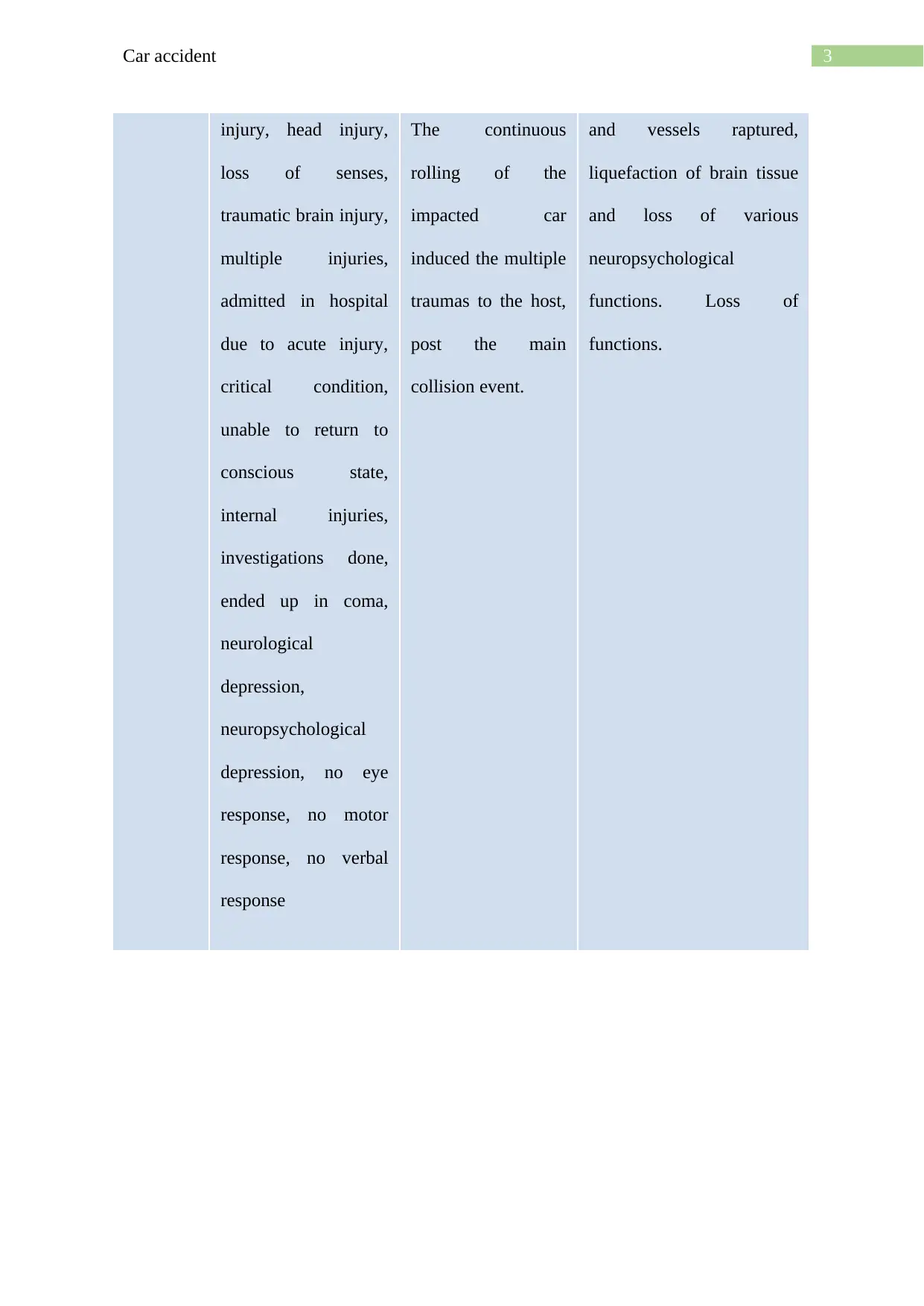
3Car accident
injury, head injury,
loss of senses,
traumatic brain injury,
multiple injuries,
admitted in hospital
due to acute injury,
critical condition,
unable to return to
conscious state,
internal injuries,
investigations done,
ended up in coma,
neurological
depression,
neuropsychological
depression, no eye
response, no motor
response, no verbal
response
The continuous
rolling of the
impacted car
induced the multiple
traumas to the host,
post the main
collision event.
and vessels raptured,
liquefaction of brain tissue
and loss of various
neuropsychological
functions. Loss of
functions.
injury, head injury,
loss of senses,
traumatic brain injury,
multiple injuries,
admitted in hospital
due to acute injury,
critical condition,
unable to return to
conscious state,
internal injuries,
investigations done,
ended up in coma,
neurological
depression,
neuropsychological
depression, no eye
response, no motor
response, no verbal
response
The continuous
rolling of the
impacted car
induced the multiple
traumas to the host,
post the main
collision event.
and vessels raptured,
liquefaction of brain tissue
and loss of various
neuropsychological
functions. Loss of
functions.
Paraphrase This Document
Need a fresh take? Get an instant paraphrase of this document with our AI Paraphraser
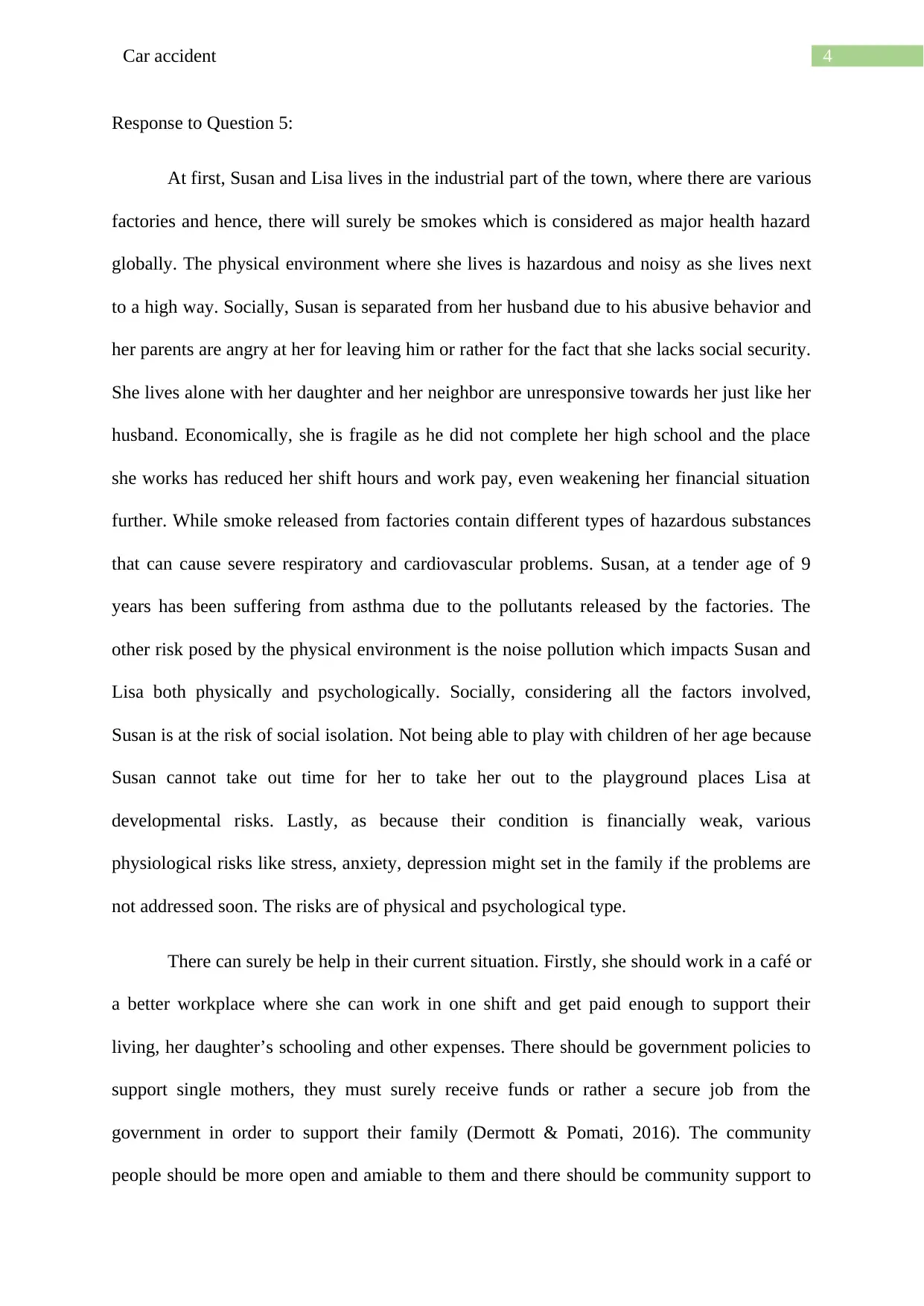
4Car accident
Response to Question 5:
At first, Susan and Lisa lives in the industrial part of the town, where there are various
factories and hence, there will surely be smokes which is considered as major health hazard
globally. The physical environment where she lives is hazardous and noisy as she lives next
to a high way. Socially, Susan is separated from her husband due to his abusive behavior and
her parents are angry at her for leaving him or rather for the fact that she lacks social security.
She lives alone with her daughter and her neighbor are unresponsive towards her just like her
husband. Economically, she is fragile as he did not complete her high school and the place
she works has reduced her shift hours and work pay, even weakening her financial situation
further. While smoke released from factories contain different types of hazardous substances
that can cause severe respiratory and cardiovascular problems. Susan, at a tender age of 9
years has been suffering from asthma due to the pollutants released by the factories. The
other risk posed by the physical environment is the noise pollution which impacts Susan and
Lisa both physically and psychologically. Socially, considering all the factors involved,
Susan is at the risk of social isolation. Not being able to play with children of her age because
Susan cannot take out time for her to take her out to the playground places Lisa at
developmental risks. Lastly, as because their condition is financially weak, various
physiological risks like stress, anxiety, depression might set in the family if the problems are
not addressed soon. The risks are of physical and psychological type.
There can surely be help in their current situation. Firstly, she should work in a café or
a better workplace where she can work in one shift and get paid enough to support their
living, her daughter’s schooling and other expenses. There should be government policies to
support single mothers, they must surely receive funds or rather a secure job from the
government in order to support their family (Dermott & Pomati, 2016). The community
people should be more open and amiable to them and there should be community support to
Response to Question 5:
At first, Susan and Lisa lives in the industrial part of the town, where there are various
factories and hence, there will surely be smokes which is considered as major health hazard
globally. The physical environment where she lives is hazardous and noisy as she lives next
to a high way. Socially, Susan is separated from her husband due to his abusive behavior and
her parents are angry at her for leaving him or rather for the fact that she lacks social security.
She lives alone with her daughter and her neighbor are unresponsive towards her just like her
husband. Economically, she is fragile as he did not complete her high school and the place
she works has reduced her shift hours and work pay, even weakening her financial situation
further. While smoke released from factories contain different types of hazardous substances
that can cause severe respiratory and cardiovascular problems. Susan, at a tender age of 9
years has been suffering from asthma due to the pollutants released by the factories. The
other risk posed by the physical environment is the noise pollution which impacts Susan and
Lisa both physically and psychologically. Socially, considering all the factors involved,
Susan is at the risk of social isolation. Not being able to play with children of her age because
Susan cannot take out time for her to take her out to the playground places Lisa at
developmental risks. Lastly, as because their condition is financially weak, various
physiological risks like stress, anxiety, depression might set in the family if the problems are
not addressed soon. The risks are of physical and psychological type.
There can surely be help in their current situation. Firstly, she should work in a café or
a better workplace where she can work in one shift and get paid enough to support their
living, her daughter’s schooling and other expenses. There should be government policies to
support single mothers, they must surely receive funds or rather a secure job from the
government in order to support their family (Dermott & Pomati, 2016). The community
people should be more open and amiable to them and there should be community support to

5Car accident
help their daily living (Epstein, 2018). She can even plan to move back to her family in order
to find social security for herself and her daughter. This can be a good strategy as it would
take her out of the current hazardous environment she lives in.
help their daily living (Epstein, 2018). She can even plan to move back to her family in order
to find social security for herself and her daughter. This can be a good strategy as it would
take her out of the current hazardous environment she lives in.
⊘ This is a preview!⊘
Do you want full access?
Subscribe today to unlock all pages.

Trusted by 1+ million students worldwide
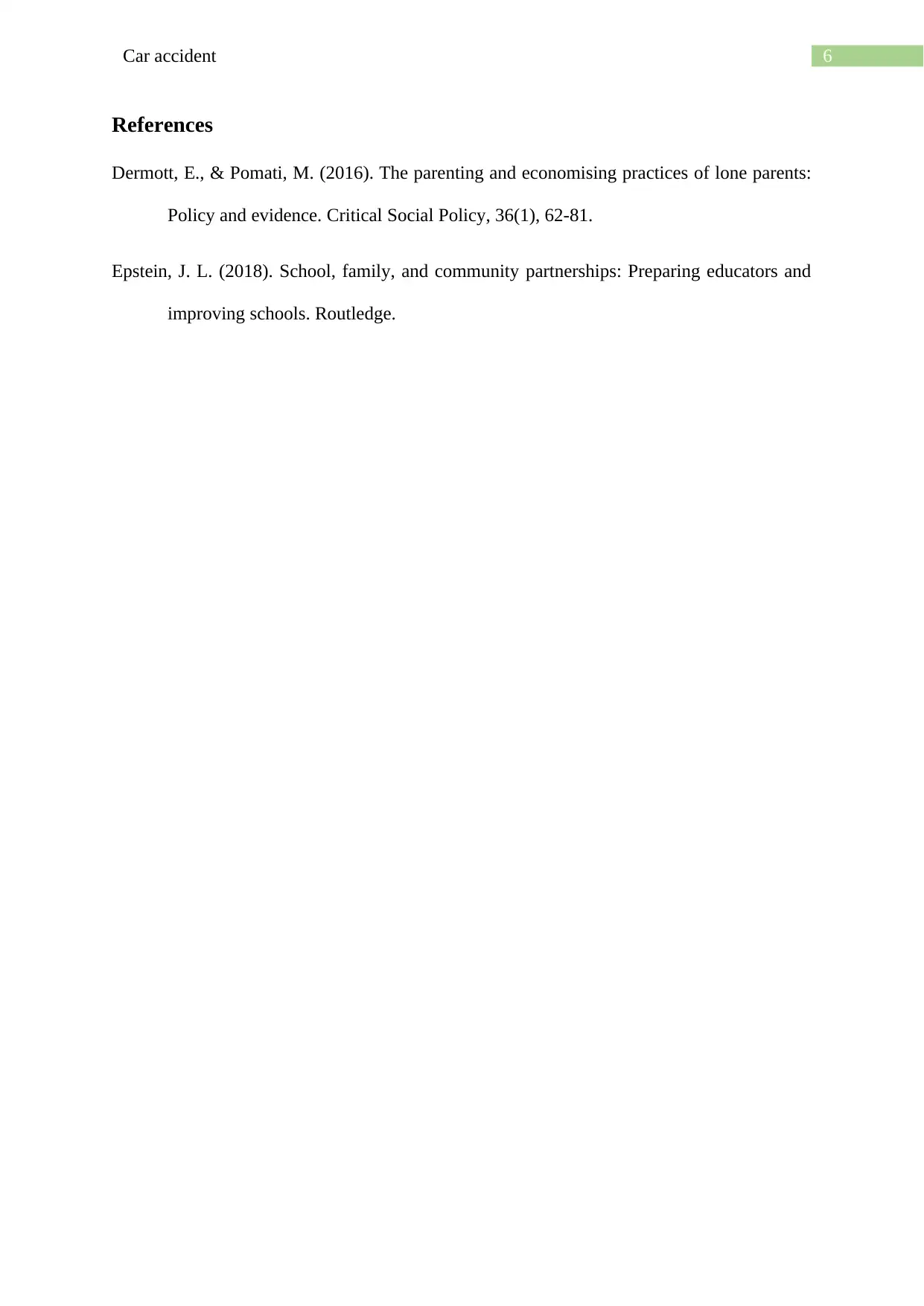
6Car accident
References
Dermott, E., & Pomati, M. (2016). The parenting and economising practices of lone parents:
Policy and evidence. Critical Social Policy, 36(1), 62-81.
Epstein, J. L. (2018). School, family, and community partnerships: Preparing educators and
improving schools. Routledge.
References
Dermott, E., & Pomati, M. (2016). The parenting and economising practices of lone parents:
Policy and evidence. Critical Social Policy, 36(1), 62-81.
Epstein, J. L. (2018). School, family, and community partnerships: Preparing educators and
improving schools. Routledge.
1 out of 7
Your All-in-One AI-Powered Toolkit for Academic Success.
+13062052269
info@desklib.com
Available 24*7 on WhatsApp / Email
![[object Object]](/_next/static/media/star-bottom.7253800d.svg)
Unlock your academic potential
Copyright © 2020–2025 A2Z Services. All Rights Reserved. Developed and managed by ZUCOL.
